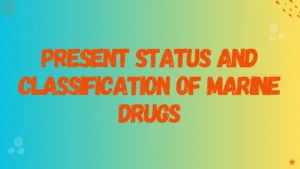Present status and Classification of marine drugs

Present status and Classification of marine drugs
Objective
At the end of this lecture, students will be able to:
Marine Pharmacognosy
• Discuss the status of marine Pharmacognosy
• Classify drugs of marine origin
Marine Pharmacognosy
• The use of marine organisms when compared to that to plants and animals is very restricted
• Marine plants and animals have been used as food for ling time, but as sources of biologically active compounds has been confined to last 40 years
• There are several well-known marine products like cod liver oil, Shark liver oil, halibut liver oil, spermaceti, protamine sulphate, agar, carageenan, alginic acid etc
• Marine macroalgae and seaweeds are used in the treatment of iodine deficiency state like goitre Basedow’s disease, hypothyroidism, supplements of vitamins during pregnancy, intestinal disorders, as vermifuge, hypoglycemic, hypocholestremic agents etc
• Sea weeds have been employed as dressings, ointments and in gynaecology
• Porphyra atropurpurea – burns and wounds
• Durvillaea antartica – scabies
• Laminaria digitata – cervical dilation
Present status
• The number of potential compounds isolated form a marine realm has virtually soared and this number now exceeds to 10000 with hundreds of new compounds still being discvoverd every year
• Many of these compounds have been obtained from marine microorganisms as well as invertebrates like sponges, molluscs, bryozoans, ascidians etc
• Some of the commercialized products from marine source include
• Antibiotic – cephalosporin
• Cytostatic – cytarabine
• Anthelmintic – kainic acid
• Analgesic – zincototide
• Antiviral – Ara A
• Antitumour – Ara C
Interesting marine bioactive molecules with their mechanism of action
• Ion channels targeting molecules
• Cone snail venoms – Selective peptide antagonists and G protein coupled receptors
• Alpha Conotoxins – calcium channel blockers
• K Conotoxins – potassium channel blockers
• Conotoxins – soidum channnel blockers
• Conotoxin group contain more than 50000 distinct molecules is reflected by more than 100 patents
DNA interactive agents
• Established anticancer agents are DNA interactive agents
• Because of lack of specificity of these drugs for cancer versus normal cells, question of developing as target as anticancer drugs has been raised
• DNA interactive compounds form marine sources include Dercitin as acridine alkaloid form the sponge of genus Dercitus; Topsentins a bisindole alkaloid
Microtubule interfering agents
• Microtubule inhibitors acts at the G2 and M phase and lack some of the worst effects of medicines that block DNA synthesis
• These natural products do not act on DNA directly, but prevent the formation of the internal microtubules which play a role in the separation of chromosomes in the final M phase of the cycle
• Taxol – a tubulin binding agent prompted to explore microtubule targeting agents from different sources from marine organisms
• The compounds yielded from marine sources include discodermolide (sponge), eleutherobin (soft coral), dolastatin (sea hare), halichondrin B (Sponge) etc
• Even though all these compounds exhibit general cytotoxicity, only dolastatin 10, dolastatin 15 analogues, cemadotin, discodermolide have so far reached clinical development
Other marine natural products
• equalamine lactate – antiangiogenic aminosteroid from dogfish shark for ovarian and lung cancer
• IPL512602 – a synthetic analogue of steroid contignasterol form the sponge Petrosia contignata for leucocyte-suppressing anti-inflammatory dung in asthma
• Fish oils are sources of PUFA are of great importance due to their physiological effects like
• Prevention of antherosclerosis
• Role in anti-ageing
• Role in brain development in premature infants
Classification of Marine Drugs
The various class of compounds includes
• Cytotoxic/anticancer agents
• Cardiovascular active drugs
• Marine toxins
• Anti-microbial drugs
• Antibiotic substances
• Anti-inflammatory agents
• Antispasmodic agents
• Antiviral agents
• Antiparasitic compounds
• Anticoagulants
• Prostaglandins
• Proteins
Present status and Classification of marine drugs Summary
• Marine plants and animals have been used as food for ling time, but as sources of biologically active compounds has been confined to last 40 years
• Cod liver oil, Shark liver oil, halibut liver oil, spermaceti, protamine sulphate, agar, carageenan, alginic acid etc
• Ion channel targeting molecule, DNA interactive, microtubular interfering agents
• Classification – Anti cancer, anti-microbial, anti-inflammatory, cardiovascular, antibiotic, anti-viral, anti-spasmodic etc